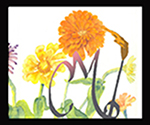When the alcohol has dried, then you’re ready to work with the soft pastels. I like to get the background in first and then I can tweak it later if necessary. I’ve decided on a very loose background and the head for the dog with bird in mouth.
I begin on the eyes and around the eyes making sure to keep the right shape – at this point, sometimes it’s a good idea to lay the tracing paper over it to be sure you haven’t lost the position of the eyes, nose and muzzle. Keep referring to the photo. I use a pastel pencil or black charcoal pencil on the eye. Also use a very small shaper (see below). The black is pretty harsh so will go over it with a dark brown pastel pencil. I use the pencils on the inside of the eye too. This reference has a shadow on the right eye so that goes in now too.
Next I move on to the overall head fur. Be sure to use the strokes as the hair grows. Start out with the darks and you may have to go over the area a few times using one color pastel and then another and back again. Use a light touch as you can always add more pastel. I used a light lavender gray for the gray in the face fur. These are my colors.
Pastel brands and colors I’ve used on this painting: I have a set of Terry Ludwig pastels which are very soft, I special ordered 11colors of gold, rust and browns that are just for painting the goldens. I keep them in their own box so they don’t get mixed in with my other pastels.
To this I add a few Girault pastels in similar colors (also added 2 lavender gray. I like the Giraults as they have more grit and harder than the Ludwig’s – great for blending from one color to another in the fur. If you paint a lot of one breed of dog, it is well worth the expense to get pastels that match your dog.
I’m slowly working my way down the neck of the dog. The bird will be last. I’ve changed the bird to an upland game bird, the pheasant.
Next will continue painting the bird.




